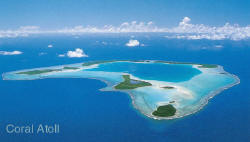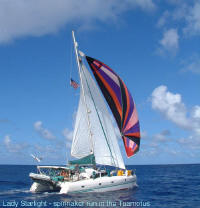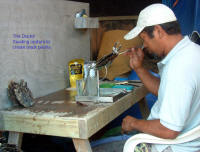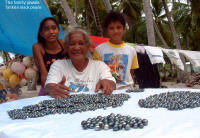American Samoa and Samoa
Cook Islands Fiji
Marquesas Moorea
New Caledonia
Pacific Crossing
Pacific Log Pacific Route
Pacific Passage Planning
Society Islands
Tahiti Tonga
Tuamotus Vanuatu

July- August 2002
The Pacific atolls are one of the most fascinating places on earth. They are like a shallow turquoise swimming pool in the middle of the deep Pacific ocean. Understanding how they are formed is part of what makes them so special. The Pacific islands fall into 3 categories. Youngest are the Marquesas which are majestic volcanic mountains rising straight out of the ocean floor. Over millions of years a coral reef will begin to form around the edge of the island. After many millennia pass you will have an island like Tahiti or Bora Bora where there is a tall volcanic island surrounded by a coral reef. The reef will completely encircle the island and may be anywhere from 50 yards to several miles offshore. In between the outer reef and the main island is a stunning coral lagoon where the shallow water is calm and clear and a beautiful turquoise color. As a few million more years pass the coral reef will continue to build up on the outside while the tall volcanic island on the inside is eroding away. Eventually the entire inside island erodes back into the sea while the billions and billions of living organisms that make up a coral reef continue to build. In time the result is an atoll which is a completely circular coral reef. In a few places along the edge of the reef small sandy islands have grown up. Inside the reef there are no remnants left of the original volcano and the entire inside of an atoll may only be 10-80 feet deep surrounded by the blue Pacific dropping to thousands of feet. On land the highest place on the atoll may be 10 feet above sea level. The water inside the lagoon is often as calm as a millpond while outside huge breakers thunder onto the coral reef.
The atolls vary in size from a few miles around to as much as 30 miles by 5 miles. In one or two places along the edge of the reef a deep pass will have opened to allow the tidal currents to enter and leave the lagoon and here is where we found our excitement. With Ventana anchored inside in the calm lagoon we would take our dinghy outside and scuba dive the outer wall. Being in deep water these areas attract large pelagic ocean fish such as tuna, jacks, and especially sharks. Our favorite pastime was to do a drift dive starting outside the pass in the ocean and ride the incoming tide into the lagoon. This was also where the most food was for the feeding fish so there was always plenty of excitement.
Sharks
Every dive we swam with dozens and dozens of sharks and on one dive we were surrounded by over 150 sharks just schooling around and darting everywhere. We hugged the rocks and watched them in fascination for about 10 minutes until it slowly dawned on us that the "watchers" had become the "watchees." About a dozen sharks began to circle around and around us coming a bit closer on each pass. When one or two sharks darted in to within a few feet of us we flicked our fins in their faces and decided we had worn out our welcome. With the three of us hovering back to back so we could look in all directions we let the strong current carry us into the lagoon and fortunately they did not follow.
The sandy soil of the atolls makes it nearly impossible to grow much so when we came ashore with gifts of fresh Marquessan limes or pampelmouse we were warmly welcomed. Often in return we were offered fresh fish, coconuts or black pearls. Many of the younger people came out to look through our CD collections and wanted to trade pearls for copies of the latest music. Several surprised us by selecting classical music from Dee's collection.
We visited many different atolls in the Tuamotus, some sparsely inhabited and some entirely uninhabited. On the inhabited atolls the people were mostly engaged in the relatively new industry of cultivating black pearls and we were fortunate enough to meet one family who let us help them in their tasks and learn how they create these beautiful pearls. One day after cleaning and implanting the oysters we went out into the lagoon in their boat to replant them. After we snorkeled down to replant all the oyster shells they took us to another part of the lagoon where inexplicably they indicated for us to stay on the boat while one of the divers went overboard. When he came up with a large shell we thought he was checking on a different oyster bed. Instead he opened up the shell and handed Dee a beautiful round black pearl as a memento of our time with them.
To read the next installment click here.
To enlarge any photo click on it then click on the back button to return here.
To read the next installment click here.


















